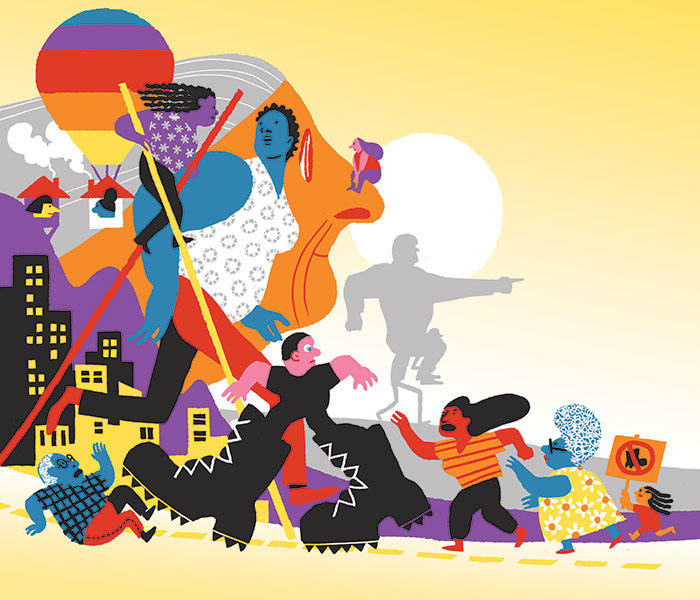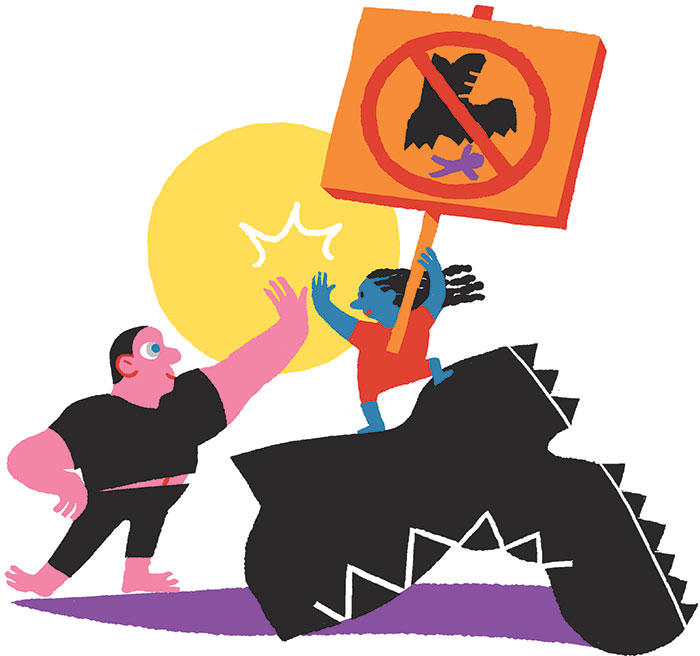The Teaching Tolerance Social Justice Standards are the anchor standards and learning outcomes created to guide educators in curriculum development and to make schools more just, equitable and safe. Our standards are designed to be used alongside state and Common Core State Standards in all content areas to reduce prejudice and bias and advocate for collective action.
These standards are divided into four domains: Identity, Diversity, Justice and Action. This PD Café is the third in a series walking educators through the domains of the Social Justice Standards. Please see PD Café in the Spring and Fall 2019 issues of Teaching Tolerance for more information about the Identity and Diversity domains. Read on to learn more about our Justice domain—and how you might share it with students.

Understanding Justice
What Is Justice?
- The maintenance or administration of what is just, especially by the impartial adjustment of conflicting claims or the assignment of merited rewards or punishments
- The administration of law, especially the establishment or determination of rights according to the rules of law or equity
- The quality of being just, impartial or fair
- The principle or ideal of just dealing or right action
The Merriam-Webster Dictionary
For younger students, you may simply explain that justice is, in many ways, a combination of fairness and opportunity: In a just society or group, people have the same rights and are not punished more because of who they are.
Exploring Justice
In the story “Teaching Kindness Isn’t Enough,” Bret Turner writes, “Moving … toward real justice begins with building an identity-safe classroom: a place where everyone’s story is not only recognized but honored, studied and loved. This means moving beyond a curricular focus to make justice part of a class’s daily culture.” Students need to first understand their own identities and celebrate the diversity of those around them to be in a community where justice can exist.
When examining justice with students, it’s important for them to have concrete definitions of both justice and injustice so they can celebrate justice and also call out injustice when they see it. You can ask students to answer the following questions:
- What is justice?
- How do you know when you see or experience it?
- Do you know of people who have fought for justice?
- What are some ways that injustice can hurt people or groups?
Students can explore the answers to these questions using our teaching strategy “Save the Last Word For Me.”
For grades K–5, students can discuss the following questions after reading “The Story of Suzie King Taylor”:
- Why did the children have to hide the books?
- How is not having access to books a form of injustice?
- How did the children use what they learned to fight for justice?
Students in grades 6–12 can discuss the following questions after reading an excerpt from Studs Terkel’s “Community in Action”:
- What was unjust about how the family was treated during the Great Depression?
- How did the community demonstrate justice in its response?
Finally, students can think more deeply about injustice by discussing it together.
Write the following question in the center of pieces of chart paper: “What major events or systems have had a role in creating injustice in our world today?”
Divide students into pairs or small groups. Give each a piece of paper with the question in the middle and have them record their answers on it. Using the teaching strategy “Text Graffiti,” have students record their responses and respond to peers’ answers.
After a few minutes, students can choose an event or system and brainstorm solutions that would be more just. They can refer back to their discussion about what justice looks like.
After brainstorming solutions, come back together as a class. Students can share their ideas and discuss the following questions:
- Is there one right way to combat injustice?
- Does justice look the same for everyone?
- Does everyone have a responsibility to combat injustice, even if it doesn’t directly affect them?
Justice Standards
Anchor Standards 11–15 of the Social Justice Standards
11. Students will recognize stereotypes and relate to people as individuals rather than representatives of groups.
12. Students will recognize unfairness on the individual level (e.g., biased speech) and injustice at the institutional or systemic level (e.g., discrimination).
13. Students will analyze the harmful impact of bias and injustice on the world, historically and today.
14. Students will recognize that power and privilege influence relationships on interpersonal, intergroup and institutional levels and consider how they have been affected by those dynamics.
15. Students will identify figures, groups, events and a variety of strategies and philosophies relevant to the history of social justice around the world.

Scenario #1
A class is discussing César Chávez and the American labor movement. Kelly mentions seeing on TV that most of the clothes sold in the United States are made in other countries, where workers aren’t protected the way laborers are in the United States. She notes that even though workers’ conditions have improved in the U.S., that doesn’t mean that we should ignore injustice elsewhere. She and several other students are inspired to go home and talk to their parents about purchasing clothes from companies that practice ethical manufacturing. They also plan to set up a clothes swap to help reduce wastefulness.
- Which of the five Justice anchor standards are demonstrated in Kelly’s story?
Scenario #2
Malik notices that many of their classmates with disabilities face challenges as they navigate the school and are often late to class as a result. Malik decides to look into building plans to determine if any accommodations are available for people with disabilities. They form a focus group of students and faculty to come up with effective solutions to the situation.
- Which of the five Justice anchor standards are demonstrated in Malik’s story?
- How do Malik’s observations demonstrate an understanding of justice beyond their own lived experience?
Essential Questions
Pushing students to examine justice and injustice is critical. You can incorporate the Justice standards into your classroom practice when you write essential questions for your units of study. Below are two examples from different content areas.
Third Grade Social Studies
J.12: How do the three branches of the U.S. government promote fairness? Are there examples of times when the government hasn’t been just to all people?
Sample Answer: Students can begin by discussing how checks and balances among the three branches of the U.S. government are supposed to ensure fairness. For example, they may mention that these rules keep one person (or branch) from controlling the government, interpreting the Constitution or enacting laws. Students can discuss how, in theory, having three equal branches of government lets more voices be heard when the government makes the rules for our country and decides how to treat people. They can go further by discussing ways in which the U.S. government hasn’t always been just to all people. For example, they may have learned that certain groups of people have not been allowed to vote at different times in history (and today) and therefore weren’t (and aren’t) represented in the executive or legislative branches. Students can consider how this lack of representation might affect which rules or laws are passed by the legislature and approved by the executive.
Ninth Grade ELA
J.13: How do John Lewis’ actions in March show an understanding of injustice, and what actions did he and others take to raise awareness of injustices?
Sample Answer: Answers will vary. Students reading March: Book One may point to Lewis’s participation in a group called the Nashville Student Movement. They can discuss how the group understood that Jim Crow laws and segregation impacted all communities by dividing people on racial lines and fueling hate, and Jim Crow impacted Black people specifically by denying them their humanity and basic services. Students should note that the group protested segregation by conducting nonviolent sit-ins at lunch counters that only served white people. They faced consequences like verbal abuse, physical violence and arrest. Students may cite the story’s depiction of Nashville students planning the sit-ins, illustrating their understanding of injustice and tactics for combating it. Students can go further by discussing how the narrative of March: Book One points to the ways these actions inspired more activism—such as the boycott of all downtown Nashville stores—and how these actions sowed seeds of change, forcing leaders like Nashville Mayor Ben West to engage the issue and consider desegregation. Students with a firm understanding of Justice Standard 13 should be able to articulate how bias and injustice led to harmful actions by both individuals and government. In March’s description of the lunch counter sit-ins, for example, students can cite details of individual abuse (verbal and physical) as well as the legalized segregation that allowed it to happen.
Now you try! Write an essential question based on one of the five Justice standards for your own grade level or content area.